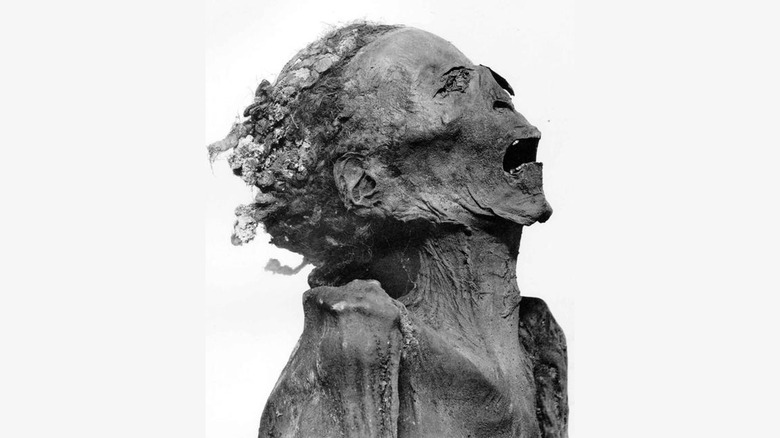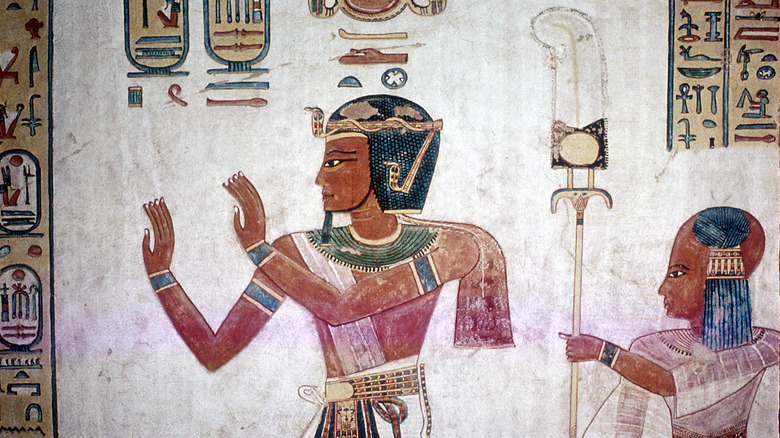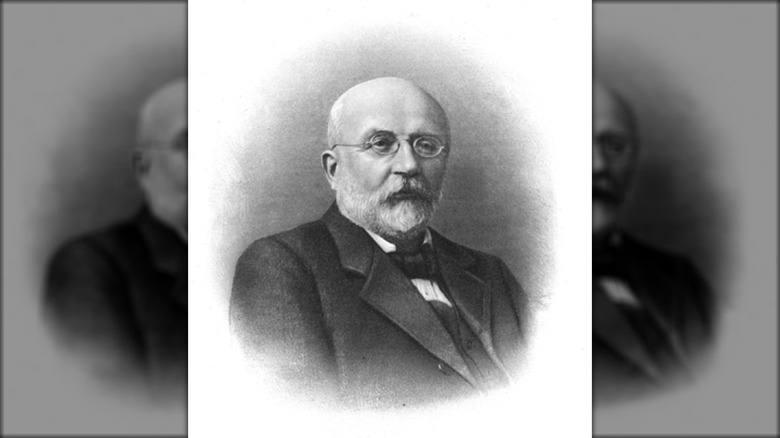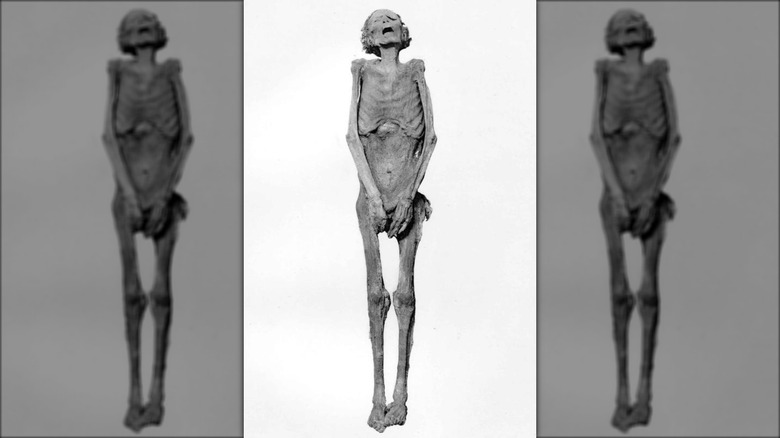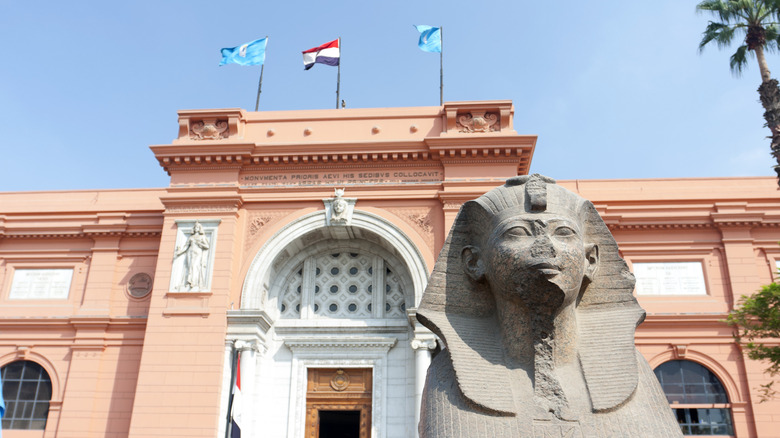Here's How Experts Think The 'Screaming Mummy' Actually Died
The image of Egyptian burial as it is remembered today appears both luxurious and elegant, with sumptuous sarcophagi encasing the mummified remains of their pharaohs and nobility, a precaution, they believed, that would ensure their safe passage to the afterlife. Egyptians even mummified and created beautiful burial plots for their cats, animals they revered.
But for many years Egyptologists have been puzzled by the existence of one particularly horrifying specimen of Ancient Egyptian remains. It is the body of a man, which, rather than lying calmly like the remains of other mummies, lies with its mouth agape, its head thrown back in apparent pain. Known as the "Screaming Mummy," little was known about exactly why his death throes were seemingly so agonizing. But with the help of ancient chronicles as well as 21st-century genetic evidence, scientists and historians have pieced together his story, which places him at the center of a treasonous parricidal plot that ultimately led to him being forced to take his own life. His name, according to some experts, was Prince Pentawere.
[Featured image by Khruner via Wikimedia Commons | Cropped and scaled]
The plot against Ramesses III
The circumstances of the fate of Pentawer a.k.a "The Screaming Mummy" are closely related to those of Pharoah Ramesses III, who himself died in brutal circumstances after around three decades as the supreme ruler of Egypt from around 1187 B.C. to 1156 B.C. Despite his enormous power as a demigod among his people, Ramesses' long reign culminated in widespread disgruntlement among the populace as they were struck by economic struggles and food shortages.
With the pharaoh's power draining away, one of his wives, Tiye, formed an audacious plan along with other members of Ramesses' harem to murder her husband and install her son, Pentawer, in his place. Ramesses' mummy, which is housed at the Egyptian Museum in Cairo, is, on its surface, immaculate. For decades, experts could find no evidence that the "Harem Conspiracy" had succeeded in its murderous objectives. However, in 2012 it was discovered through a CT scan on a bandage that remained intact on Ramesses' neck that it was hiding a previously unnoticed wound. Analysis suggested that Ramesses had been dealt a fatal knife blow, possibly from behind. A second injury, to his toe, led experts to conclude that he had been simultaneously attacked from the front. Nevertheless, it seems that although the assassins may have succeeded in Ramesses III, they were captured in the attempt, and made to face justice by his loyalists.
The discovery of Unknown Man E
The "Screaming Mummy" first came to light back in 1886, in an age when explorers and looters raided Egyptian tombs with next to no oversight, leaving with treasures, trinkets, and the bodies of those who had been laid to rest more than 3,000 years ago. However, not everyone was looking to make a quick buck from the tombs of dead pharaohs. The French Egyptologist Gaston Maspero (pictured), a former Egyptian language teacher in Paris, had, as director general of excavations and antiquities, been empowered by the Egyptian government to protect against graverobbers and uncover and catalog a major tomb believed to be the final resting place of some of the country's most prominent ancient pharaohs. It was in this tomb, discovered among the remains of 40 sets of royal remains those of the "Screaming Mummy," of which a physician who examined the corpse said: "The last convulsions of horrid agony can, after thousands of years, still be seen" (per Archaeology).
In 2006, archeologist Bob Brier wrote an article in "Archaeology," the journal of the Archaeological Institute of America, noting that the "Screaming Mummy," known to archaeologists as "Unknown Man E," has been the subject of speculation in the field for more than a century. One theory goes that the corpse is that of a Hittite prince who had arrived in Egypt to marry an Egyptian princess, but who had been murdered en route. However, details of the burial later suggested another story.
Buried in disgrace
Though the "Screaming Mummy" was buried with members of Egyptian royalty, experts believe there is evidence in the manner of his burial that at the time he was considered a disgraced figure, providing more evidence that he may have been the would-be usurper Prince Pentawere. Usually, prominent figures in Ancient Egypt underwent an elaborate mummification process after death, which included embalming and the removal of organs, as well as efforts to repair injuries with the use of amulets, or replacement body parts. The "Screaming Mummy" had been subjected to none of these rituals, and in fact had been wrapped in goat or sheep skin (reports vary), a material thought impure by the Ancient Egyptians.
In 2012, experts removed a sample from the "Screaming Mummy" to perform DNA analysis that they hoped would offer an insight into the true lineage of the agonized corpse. The results were mindblowing. In an article in the British Medical Journal titled "Who killed Ramesses III?" the team led by the Egyptologist Zahi Hawass revealed that the "Screaming Mummy" shared Ramesses III's DNA, meaning that he was almost certainly his son.
[Featured image by G. Elliott Smith via Wikimedia Commons | Cropped and scaled]
Early theories
With such details in mind, Zahi Hawass and his team stated that Unknown Man E a.k.a the "Screaming Mummy" is a "good candidate for Pentawere," per the British Medical Journal. As recorded in an Ancient Egyptian document known as "The Judicial Papyrus of Turin" (pictured) Pentaware died by suicide as a direct consequence of his plot against his father, Ramesses III. The death — which would allow his body to remain intact for the afterlife — would have been preferable to some of the more disfiguring execution methods reserved for the lower orders of Egyptian society. However, the exact method of Pentawere's death was not recorded.
Those who discovered the body initially thought, on account of his chilling appearance, that he must have been buried alive (per "Archeology"). As the years passed, the theory emerged that he may have died by poison. Poisoning was a common means of forced suicide in antiquity; famously, the philosopher Socrates convinced his students of the existence of the afterlife through a series of dialogues before he was forced to swallow hemlock, which killed him instantly. But further study has revealed that there may be more to Prince Pentawere's death.
[Featured image by Khruner via Wikimedia Commons | Cropped and scaled]
Evidence of hanging
In 2018, the remains of the "Screaming Mummy" were put on display at the Egyptian Museum in Cairo (pictured), fuelling yet more interest in the story of Prince Pentawere's part in a plot to murder his father Ramesses III, and the cause of death that created such a horrifying expression which still has the power to chill 3,000 years after his attempted coup.
Further examination of the "Screaming Mummy" revealed at the time of the DNA analysis confirmed that there were marks on the corpse's neck which the Eurac Research Institute's Albert Zink tells Channel 5's "Ancient History" that are consistent with hanging, however, Zahi Hawass reported in the British Medical Journal that if strangulation was the cause of death there should be laryngeal fractures, and none were found. Whether the prince may have taken poison is still debated among experts. Meanwhile, the fate of Pentawere's mother and co-conspirator, Queen Tiye, who hatched the plan which left both Ramesses and her son dead, remains unknown.
